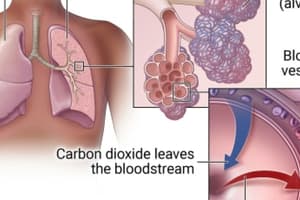Podcast
Questions and Answers
Which part of the respiratory system is responsible for gaseous exchange with the lungs?
Which part of the respiratory system is responsible for gaseous exchange with the lungs?
- The trachea
- The lower respiratory system
- The bronchial tree (correct)
- The upper respiratory system
What is the main function of the pulmonary circulation?
What is the main function of the pulmonary circulation?
- To remove carbon dioxide from the body
- To deliver deoxygenated blood to the lungs (correct)
- To deliver oxygenated blood to the body
- To remove oxygen from the lungs
Which part of the respiratory system is involved in conducting air to the lungs?
Which part of the respiratory system is involved in conducting air to the lungs?
- The lower respiratory system
- The systemic circulation
- The upper respiratory system (correct)
- The respiratory zone
What is the role of the muscles involved in respiration?
What is the role of the muscles involved in respiration?
What is the process by which the body takes in oxygen and gets rid of carbon dioxide?
What is the process by which the body takes in oxygen and gets rid of carbon dioxide?
Flashcards are hidden until you start studying
Study Notes
Respiratory System and Gas Exchange
- The alveoli are the primary structures in the lungs where gaseous exchange occurs, facilitating oxygen uptake and carbon dioxide release.
- Alveoli are small, balloon-like structures surrounded by capillaries that enhance the diffusion process due to their large surface area.
Pulmonary Circulation
- Pulmonary circulation is responsible for transporting deoxygenated blood from the heart to the lungs and returning oxygenated blood back to the heart.
- This circulation plays a critical role in ensuring blood is oxygen-rich before it is pumped to the rest of the body.
Conducting Air to the Lungs
- The conducting zone includes structures such as the trachea, bronchi, and bronchioles, which transport air to the lungs while filtering, humidifying, and warming it.
- These pathways ensure that air reaches the alveoli efficiently for gas exchange.
Muscles Involved in Respiration
- The diaphragm and intercostal muscles are the main muscles of respiration; the diaphragm contracts and flattens to increase thoracic cavity volume.
- Intercostal muscles assist in expanding and contracting the ribcage, further aiding in the mechanics of breathing.
Process of Breathing
- Respiration is the process by which the body inhales oxygen (via inhalation) and excretes carbon dioxide (via exhalation), crucial for cellular metabolism.
- This process is vital for maintaining acid-base balance and overall homeostasis in the body.
Studying That Suits You
Use AI to generate personalized quizzes and flashcards to suit your learning preferences.




